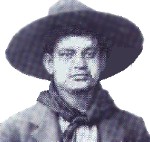 Crawford
Goldsby, an Oklahoma outlaw better
known as Cherokee Bill, was born at
Fort Concho, Texas, on February 8,
1876, the son of St. George and Ellen
(Beck) Goldsby. He had three siblings,
sister Georgia and brothers Luther and
Clarence.
Crawford
Goldsby, an Oklahoma outlaw better
known as Cherokee Bill, was born at
Fort Concho, Texas, on February 8,
1876, the son of St. George and Ellen
(Beck) Goldsby. He had three siblings,
sister Georgia and brothers Luther and
Clarence.
The elder
Goldsby (from Alabama) was in the Tenth
United States Cavalry and claimed to be
of black, Sioux, Mexican, and white
ancestry. He had been in the Army in
Texas. Because of a fracas in Texas, he
went AWOL and escaped to Indian
Territory (now Oklahoma).
Bill's mother
was reportedly half black, one-fourth
white, and one-fourth Cherokee. She had
been born in the Cherokee nation,
Delaware District. Her parents had been
owned as slaves at one time by a
Cherokee, Jefferey Beck. After having
been left by her husband in Texas, she
went with her family to Fort Gibson,
Indian Territory, leaving Crawford
behind in the care of a black woman,
Amanda Foster. She took care of him
until the age of seven when he moved
with his mother to Fort Gibson and then
was sent to Cherokee, Kansas to Indian
school for three years. He then went to
the Carlisle Industrial School for
Indians in Carlisle, Pennsylvania, for
two years, but some sources state that
he could barely read and write.
After leaving
school at the age of twelve, he
returned to Oklahoma.
His mother had
remarried when he was thirteen. He
apparently didn't get along with his
new stepfather well. He started hanging
around with a bad crowd, drinking
liquor and rebelling against
authority.
At fifteen, he
went to live with his sister, Georgia,
and her husband.
At seventeen,
he worked on a ranch where it was said
he was well liked by all.
At eighteen,
while attending a dance at Fort Gibson,
Texas, he shot Jake Lewis twice for
beating up Crawford's little brother.
He then headed for the Creek and
Seminole Nations (now Oklahoma) where
he met Jim and Bill Cook, a couple of
outlaws.
In the summer
of 1894, the Cook's and Crawford got
the owner of a restaurant to go and
collect some money due each of them as
a payment share for some Indian land
called the Cherokee Strip. The
government had bought the land. She did
collect the money for all three, and on
her return was followed by a sheriff's
posse trying to catch up with the
Cooks. There was a gunfight at one
point, one killed and one wounded. The
owner of the restaurant was questioned
about the gunfight and was asked if
Crawford was amongst the group. She
replied no but that it was the Cherokee
Kid. This, apparently, was where he
gained his nickname.
The famous Cook
gang made itself known across the
Cherokee and Seminole Nations (in now
Oklahoma) in July, 1894 with robberies
and murder.
Some of his
biographers contend that he did not
begin the exploits that made him
infamous until the age of eighteen.
Others, however, believe that he killed
his first victim when he was only
twelve. Biographers also are uncertain
when he received the name Cherokee
Bill. He murdered at least seven people
and may have killed as many as
thirteen. Certainly by the time he
reached eighteen he had joined the Bill
Cook gang in bank and train robberies.
Bill later formed his own gang and also
rode with such well-known outlaws as
Henry Starr and Billy
the Kid.
With the assistance of acquaintances
who hoped to receive part of a $1,500
reward, federal authorities captured
Bill and transported him to the federal
district court in Fort Smith, Arkansas.
There he received a capital conviction
for the murder of an unarmed painter
who happened to witness Bill's
participation in a robbery. However,
Bill's lawyer appealed the conviction,
maintaining that Bill had not received
a fair trial in the court of Judge
Isaac Parker, a jurist known for his
disdain for lawbreakers. After an
unsuccessful escape attempt in which he
killed a jail guard at Fort Smith, Bill
received a second murder
conviction.
When the United
States Supreme Court rejected his
appeal of his first conviction, federal
officials hanged him before hundreds of
onlookers, on March 17, 1896. His last
reported comment was, "I came here to
die, not to make a speech."
Judge Parker
characterized Bill as a "bloodthirsty
mad dog who killed for the love of
killing" and as "the most vicious" of
all the outlaws in the Oklahoma
Territory. Numerous publications
recounted Bill's life of crime. After
his death, his mother took his body to
the Fort Gibson area, where he was
probably buried.
Ref
"GOLDSBY,
CRAWFORD."
The Handbook of Texas
Online.